Geoscience Reference
In-Depth Information
30˚
60˚
90˚
120˚
15
0
˚
30˚
30˚
(a)
India
(b)
0˚
0˚
Maldives
Sri Lanka
2
Bangladesh
4
Myanmar
-30˚
-30˚
Andaman Is.
1941 (7.7)
1881 (7.9)
Thailand
1881 (7.5)
Ace
h
Nicobar Is.
-60˚
-60˚
Malaysia
2004 (9.3)
2005 (8.7)
1861 (8.5)
30˚
60˚
90˚
120˚
150˚
Nias Is
1797 (8.2)
1833 (9.0)
80
TOPEX/Poseidon
(c)
Sumatra
2000 (7.9)
40
Run-up height - 20 m
0
Date and epicenter of earthquakes in the region
40
-80
-10˚
0˚
10˚
20˚
Latitude
Fig. 6.11
Map of the Indian Ocean for the December 26, 2004
Sumatran earthquake. a Travel time of the tsunami across the ocean.
Based on National Geophysical Data Center (
2006a
). b Location and
magnitudes of epicenters of the 2004-2005 earthquakes and previous
earthquakes in the region. Based on Subarya et al. (
2006
). c Height of
the tsunami as measured by the TOPEX/Poseidon satellite 2 h after the
earthquake. Based on National Oceanic and Atmospheric Administra-
tion (
2006
). Run-up heights in (a) and (b) based on Choi et al. (
2006
)
The height of the tsunami on local tide gauges is difficult
to ascertain because many were destroyed (Choi, et al.
2006
). No records exist in northern Sumatra. At Phuket,
Thailand, a depth sounder located 1.6 km offshore from the
coast recorded the passage of a 6 m high wave. However,
closer to the coast, this wave did not appear to be more than
3.2 m high (Table
6.3
). Along the east coast of India, the
wave had a maximum inshore height—measured from the
trough to the wave crest—of 3.2 m (Nagarajan et al.
2006
).
In Sri Lanka, the wave at Colombo on the sheltered west
coast, measured only 2.2 m in amplitude. It was certainly
higher than this on the exposed east coast, but no tide gauge
recorded its passage. The tsunami became only one of
three—Krakatau in 1883 and the Chilean Tsunami of 1960
described above were the other two—to propagate into
other oceans. It was measured on almost every tide gauge
globally (Titov et al.
2005
). Surprisingly, mid-ocean ridges
acted as waveguides beaming tsunami wave energy into
other oceans and giving rise to some unexpected heights on
distant shores on the other side of the globe. For example,
the tsunami reached Rio de Janeiro, Brazil and Halifax,
Canada where heights of 100 and 43 cm respectively were
recorded (Table
6.3
). The tsunami had to travel 24,000 km
to reach Halifax. The energy was transmitted to these sites
around Africa via the southwest Indian Mid-Ocean Ridge
and then north into the Atlantic via the Mid-Atlantic Ridge.
Larger heights were measured at Callao, Peru 19,000 km
away in the Pacific Ocean than on the Cocos Islands lying
1,700 km southwest of the epicenter in the Indian Ocean—
68 cm versus 52 cm. The pathway to Callao again was via
mid-ocean ridges. Energy was also trapped on continental
shelves and transmitted parallel to coasts. Crescent City,
California, on the west coast of the United States, more than
23,000 km from the source of the tsunami, registered a
height of 61 cm.









































































































































































































































































































































































































































































































































































































































































































































































































































































































































































































































































